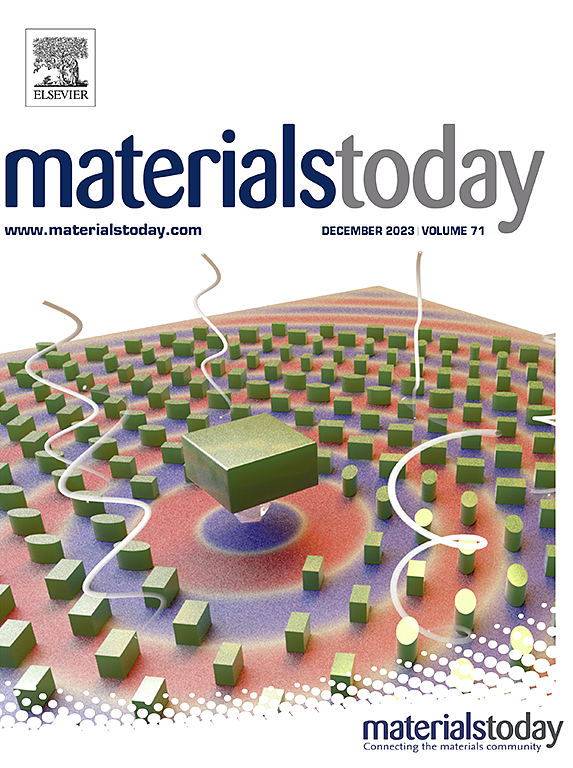A highly versatile bioenergetic-active scaffold system for customized orthopedic applications
IF 21.1
1区 材料科学
Q1 MATERIALS SCIENCE, MULTIDISCIPLINARY
引用次数: 0
Abstract
Repairing intractable bone defects, like osteochondral and large segmental defects, remains a huge challenge. Modulating intercellular energy metabolism through biomaterial design to facilitate tissue regeneration represents a breakthrough solution to the above challenge. Herein, we devised a class of highly versatile bioinks and achieved rapid 3D printing of bioenergetic-active scaffolds (BASs) tailored for orthopedic applications. These scaffolds exhibited adaptive mechanical properties and controlled degradation, releasing bioenergetic units that elevate cellular metabolic states, thereby fueling cell differentiation and tissue regeneration. For rabbit osteochondral defects, we fabricated a bioenergetic-active scaffold with a biomimetic gradient interface. Such a scaffold increased subchondral bone regeneration to 220 % of the gradient PCL scaffold and restored high-quality hyaline cartilage with rich type II collagen and typical chondrocyte arrangement, achieving a robust osteochondral interface with compressive strength comparable to that of natural tissue. Regarding large segmental femoral defects in rabbits, a mechanically adaptive bioenergetic-active scaffold was customized and greatly enhanced the diaphysis stability and bone reconstruction, achieving bone bridging across the defects. Therefore, this customizable bioenergetic-active scaffold system successfully addressed the repair of two challenging bone defects without additional growth factors and cells, demonstrating its remarkable versatility and exceptional translational prospects.

一种高度通用的生物能量活性支架系统,用于定制骨科应用
修复顽固性骨缺损,如骨软骨和大节段性缺损,仍然是一个巨大的挑战。通过生物材料设计来调节细胞间能量代谢以促进组织再生是解决上述挑战的突破性解决方案。在此,我们设计了一类高度通用的生物墨水,并实现了为骨科应用量身定制的生物能量活性支架(BASs)的快速3D打印。这些支架表现出适应性的机械性能和可控制的降解,释放生物能量单位,提高细胞代谢状态,从而促进细胞分化和组织再生。针对兔骨软骨缺损,制备了具有仿生梯度界面的生物能量活性支架。这种支架将软骨下骨再生提高到梯度PCL支架的220%,并恢复了具有丰富II型胶原和典型软骨细胞排列的高质量透明软骨,实现了与天然组织相当的抗压强度的坚固的骨软骨界面。针对兔股骨大节段性缺损,定制了一种机械适应性生物能量活性支架,大大增强了骨干稳定性和骨重建,实现了骨桥接缺损。因此,这种可定制的生物能量活性支架系统在没有额外生长因子和细胞的情况下成功修复了两个具有挑战性的骨缺陷,展示了其卓越的多功能性和卓越的转化前景。
本文章由计算机程序翻译,如有差异,请以英文原文为准。
求助全文
约1分钟内获得全文
求助全文
来源期刊

Materials Today
工程技术-材料科学:综合
CiteScore
36.30
自引率
1.20%
发文量
237
审稿时长
23 days
期刊介绍:
Materials Today is the leading journal in the Materials Today family, focusing on the latest and most impactful work in the materials science community. With a reputation for excellence in news and reviews, the journal has now expanded its coverage to include original research and aims to be at the forefront of the field.
We welcome comprehensive articles, short communications, and review articles from established leaders in the rapidly evolving fields of materials science and related disciplines. We strive to provide authors with rigorous peer review, fast publication, and maximum exposure for their work. While we only accept the most significant manuscripts, our speedy evaluation process ensures that there are no unnecessary publication delays.
 求助内容:
求助内容: 应助结果提醒方式:
应助结果提醒方式:


